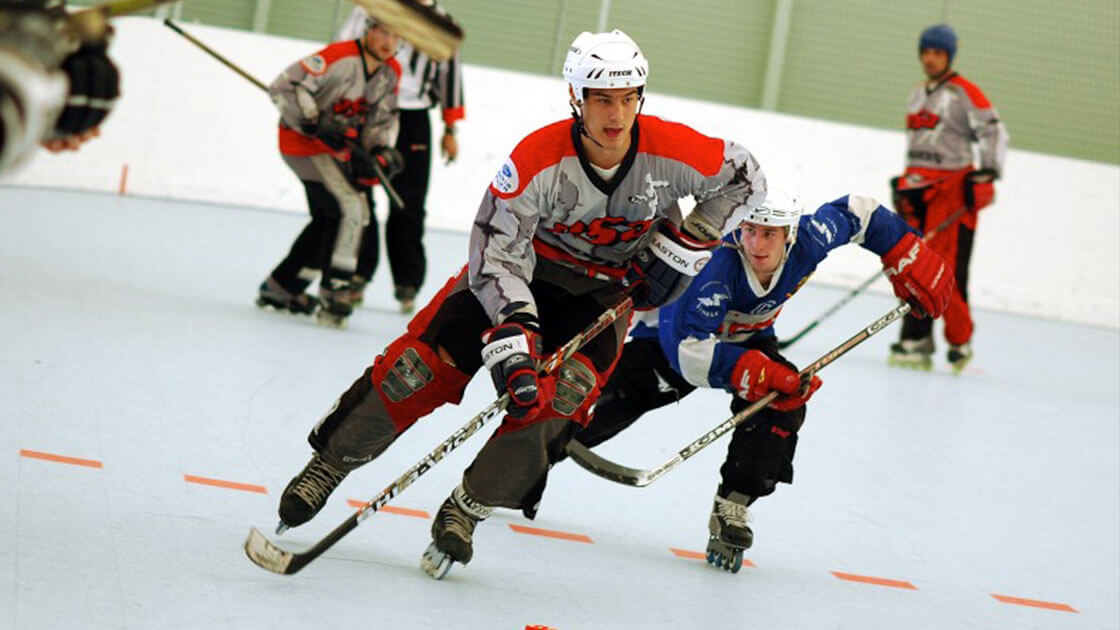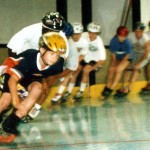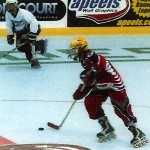Transitioning from In-line Hockey to Ice Hockey

I say it often enough, that I love my work in hockey, especially because of the great people it allows me to meet. Then, since the day I set foot (or fingers) onto Twitter, I’ve said pretty much the same thing: that I’ve met some remarkable people through social media.
Carole Lockwood Taylor, of Tyler, Texas, is such a find for me, a really nice lady I happened to meet through Facebook. More interesting, though, is the way Carole and I really got to know one another. More fascinating still, is her connection with our game, ice hockey...
Over a week or so, I’d noticed that a lady named Carole had “Liked” my different Facebook posts, and she’d even made some brief comments on a few rather general observations or comments I’d made. What really got my attention, however, was the day she added her feelings on a video I’d posted, this highlighting my summertime Mite & Squirt (primarily off-ice) Hockey School. I mean, after evidently watching it, Carole said about my video message, “THIS IS ABSOLUTELY TRUE !!!”
Huh? Why in the world would a young lady from Texas be telling me so absolutely that the principles I’d noted in the video — about how in-line skating can help hockey players — were true?
You have to know that I wrote right back to Carole and asked if she was involved in hockey, or if she was a hockey mom. And she quickly responded, “Being a former Inline Speed Skating Coach, I can tell you THIS IS ABSOLUTELY TRUE !!!”
We went back and forth from there, and I at some point let her know that I kinda pioneered the use of in-lines for ice hockey players back in my home area, and that I’d seen the miracles those efforts had produced.
The real shocker came in a later message from Carole, however…

“My son won many awards, even at Nationals, speed skating on inline skates… Then some coach called me and asked if Jeff could play on an inline hockey team… he could out-skate anyone, keep his head up, and all he had to learn was the finesse of stick handling. WHICH HE DID. In the driveway, in the house, in the street… he slept with the stick and puck. He would play 4 age divisions at Inline Hockey tournaments… 12u,14u,16u,18u, adult, when he was 12 years old. That continued until he was 18 and now coaches atoms, mites, bantams, and the Pro Inline team he is on. He tried out for and made an Elite AAA Ice Team from Houston when he was 13, having only been on the ice for the first time about 4 hours prior. I would drive him to practice in Houston from Tyler (4 hours one way)…”
Carole went on to say that the extreme costs and some personal matters ultimately ended those long trips. However, she finished with an update on her son, Jeff, in that “… he lives in Houston doing what he loves!!!”
Now, I know there’s a danger that some readers will scan that first paragraph and miss what truly took place. Oh, for sure, Carole’s son was obviously unique in his desires to do well in hockey, and he was also pretty lucky to have a mom like her. At the same time, the things he accomplished would seem rather unrealistic to anyone who doesn’t believe that in-line training can — and surely does — transfer to the ice.
Then, while Carole ultimately thanked me… “for pioneering the way for inline skaters transitioning to ice,” I think my CoachChic.com friends might find it even more interesting how I actually lucked into the earliest stages of in-line training.
Actually, my son was given the first pair of in-line skates I’d ever seen — I think by a college coach or a local pro scout. They were an Erect-a-set (if that’s how it was spelled) kind of contraption, with an ugly frame, nuts, bolts and wheels that had to be riveted onto the bottom of hockey boots. Genius that I was(n’t), I never paid much attention to those skates, except to think that they might be useful for conditioning during the summer months.
Next, a young lady named Nancilee entered the picture… In fact, she’s become famous in many of my writings, mainly because she was the inspiration for my invention, the Skater’s Rhythm-bar.
Telling the short version of the story here, a 21-year old Nancilee called my office to see if I would give her private lessons and take her from an absolute beginner to making a local ladies’ hockey team a few months down the road. Hmmmmm…
Hardly looking forward to our first meeting, Nancilee in advance had told me that she’d never been on the ice before. (Ugh!) Yet, she left the doorway onto the ice that first day and promptly twirled a quick loop around the rink surface. Whaaaat? ???
Scratching my head, I called her in, and Nancilee almost ran over me. ![]() Explaining it all — including her ability to stride — as well as her inability to stop, she simply giggled, “I in-line a lot!”
Explaining it all — including her ability to stride — as well as her inability to stop, she simply giggled, “I in-line a lot!”
Yup, that was my REAL indoctrination to in-line skating. And, man, did my mind race from that day forward… I mean, I’d seen for myself that someone could train exclusively off the ice and at least fairly well be able to skate on the ice. So, what if a combination of wheels and blades could be used to better train my hockey students? Hmmmmm…

By now, most long-time members know about my studies back in the old USSR. That’s where I learned about the true value of off-ice training. But that’s also where I discovered that the old Soviets HAD to train away from the ice because of their drastic shortage of indoor rinks. The more I thought about that, though, the more I realized that most North American amateurs have nearly the same problem. Ya, it’s hard to make headway as a youth player in our game if we’re not able to practice regularly. For sure, off-ice training — or dryland — can help immensely with that. But, then, how about being able to actually skate without the need for costly or hard-to-get ice-time?
Well, sadly, the so-called in-line craze ultimately subsided in many parts of North America. However, it’s my understanding that roller hockey is alive and well in many southern and western areas of the US. In fact, a number of recent NHL Draft choices over the past few years have grown-up in California, and they’re on record as having spent a great deal of time in their formative years on wheels.
So, I’m not saying that in-line training is dead, by any means. I know if I wanted to hold a roller practice with my ice hockey players this weekend, I could be pretty sure they all have a set of in-lines at home. And one of the reasons I hold that little guys and gals hockey school each summer is for all the reasons Carole and I have mentioned to this point. In the case of those little ones — and their young parents, however, I want to be sure I’m starting them off right, and making sure they appreciate the benefits of in-line training, and how much that actually does transfer to their on-ice game.
*
PS: Over recent years, I’ve become similarly fascinated by another cross-over sport called floorball. No, that game doesn’t involve skating, so it’s not going to totally make slideboards, wheels and ice blades obsolete. However, floorball does promise to help develop a number of other important hockey qualities I’ll be explaining more about in the future.